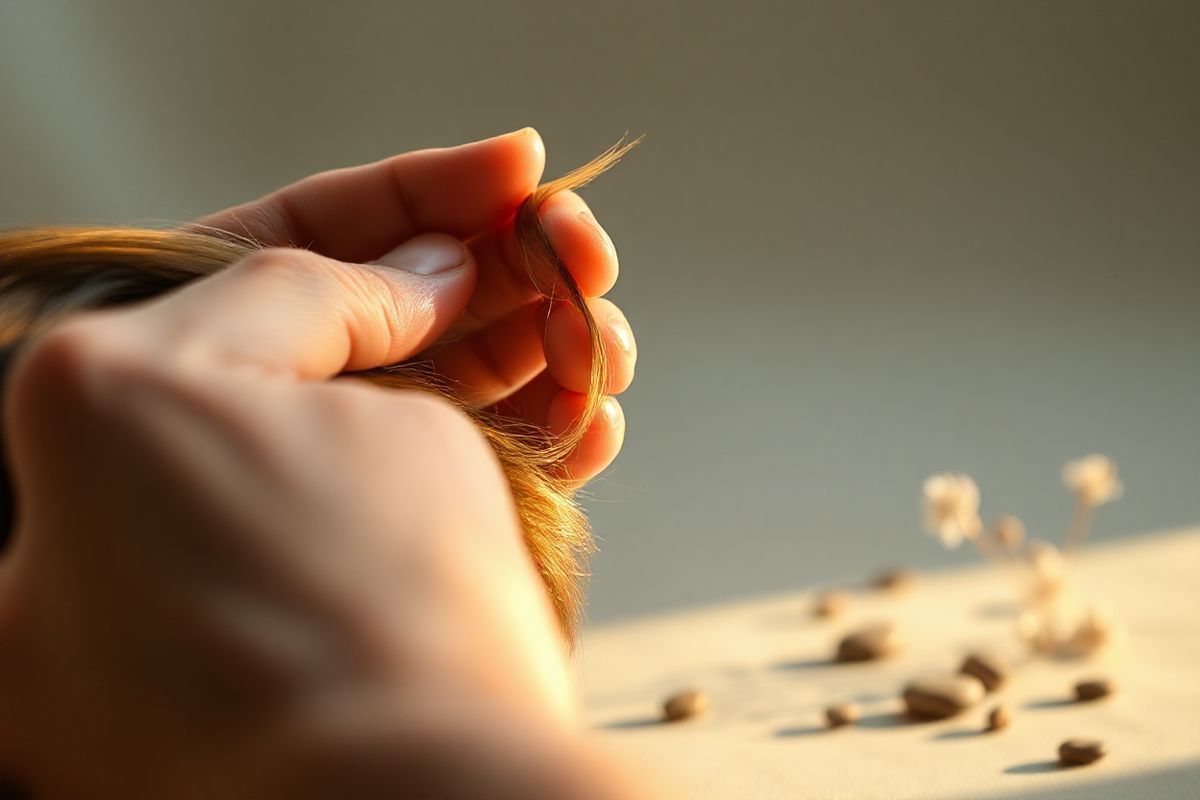Table of Contents
The Intricate Relationship Between Trichotillomania and OCD

Trichotillomania is characterized by the compulsive urge to pull out one’s hair, which can result in noticeable bald patches and emotional distress. It is classified as a body-focused repetitive behavior (BFRB) and is often associated with ocd, where individuals experience intrusive thoughts (obsessions) that compel them to engage in repetitive actions (compulsions) to mitigate anxiety (Mayo Clinic, 2023).
The overlap between TTM and OCD can be attributed to their shared neurobiological pathways. Research suggests that both disorders may involve dysfunction in the brain’s reward system and pathways associated with impulse control (Kontoangelos et al., 2024). Specifically, individuals with TTM often report feelings of relief or pleasure after pulling hair, similar to the temporary alleviation of anxiety experienced by those with OCD when performing compulsive behaviors (Mayo Clinic, 2023). Furthermore, studies indicate a significant comorbidity between TTM and OCD, highlighting the need for a comprehensive approach to treatment that addresses both conditions simultaneously (Grant et al., 2020).
Symptoms and Signs: Identifying Trichotillomania and OCD
Symptoms of Trichotillomania
Trichotillomania presents with several hallmark symptoms, including:
- Recurrent hair pulling that leads to noticeable hair loss.
- Tension before pulling or when attempting to resist the behavior.
- Pleasure or relief following hair pulling.
- Preoccupation with hair and the act of pulling, which may include examining or chewing on pulled hair.
- Distress or impairment in social, occupational, or other important areas of functioning (Mayo Clinic, 2023).
Symptoms of Obsessive-Compulsive Disorder
OCD is characterized by:
- Obsessions: Persistent, unwanted thoughts or urges that cause anxiety (e.g., fear of contamination).
- Compulsions: Repetitive behaviors or mental acts performed in response to obsessions (e.g., excessive handwashing) (NHS, 2023).
- Recognition of irrationality: Individuals with OCD often realize their obsessions and compulsions are excessive, yet they feel compelled to engage in these behaviors.
- Distress: Significant time spent on obsessions and compulsions, often impairing daily functioning (NHS, 2023).
The Psychological Underpinnings: Why Do These Disorders Occur?

Both TTM and OCD are believed to arise from a combination of genetic, environmental, and neurobiological factors. Research indicates that:
- Genetic predisposition plays a significant role, with individuals having a family history of OCD or BFRBs being at a higher risk.
- Neurotransmitter imbalances, particularly involving serotonin and dopamine, are implicated in both disorders (Grant et al., 2020).
- Environmental triggers, such as stressful life events, can precipitate the onset or exacerbation of symptoms (NHS, 2023).
- Cognitive-behavioral factors, including maladaptive coping strategies and negative reinforcement, further contribute to the maintenance of these disorders.
TablKey Psychological Factors in TTM and OCD
| Factor | Trichotillomania | Obsessive-Compulsive disorder |
|---|---|---|
| Genetics | Higher incidence in families | Family history of OCD |
| Neurotransmitters | Serotonin and dopamine dysregulation | Serotonin dysregulation |
| Environmental Triggers | Stressful life events | Major life changes or traumas |
| Cognitive Factors | Maladaptive coping strategies | Rigid cognitive patterns |
Effective Treatment Strategies: Navigating therapy for Trichotillomania and OCD
Therapeutic Approaches
Effective treatment for both TTM and OCD often involves a combination of psychotherapy and pharmacotherapy.
Cognitive Behavioral therapy (CBT)
CBT is widely considered the first-line treatment for both disorders. It includes:
- Habit Reversal Training (HRT): A behavioral intervention specifically designed for TTM that involves increasing awareness of hair-pulling triggers and replacing the behavior with less harmful responses (Woods et al., 2022).
- Exposure and Response Prevention (ERP): A CBT technique used in OCD where patients are gradually exposed to the sources of their anxiety while learning to resist the urge to perform compulsions (NHS, 2023).
Pharmacotherapy
Medications may also be prescribed to help manage symptoms:
- Selective Serotonin Reuptake Inhibitors (SSRIs), such as sertraline, have shown efficacy in treating both OCD and TTM (Kontoangelos et al., 2024).
- N-acetylcysteine (NAC): Emerging evidence suggests NAC may be beneficial for TTM, given its ability to modulate glutamate levels in the brain (Baczynski et al., 2020).
TablTreatment Options for TTM and OCD
| Treatment Type | Trichotillomania | Obsessive-Compulsive Disorder |
|---|---|---|
| Cognitive Behavioral therapy | Habit Reversal Training (HRT) | Exposure and Response Prevention (ERP) |
| Medications | SSRIs, N-acetylcysteine | SSRIs, Clomipramine |
| Support Groups | Peer support and psychoeducation | Psychoeducation and family therapy |
Living with Trichotillomania and OCD: Coping Mechanisms and Support Systems
Coping Strategies
Living with TTM and OCD can be challenging. Individuals may benefit from several coping strategies, including:
- Mindfulness and Relaxation Techniques: Practices such as meditation, yoga, and deep breathing can help reduce anxiety and improve emotional regulation.
- Support Networks: Connecting with support groups, whether in-person or online, can provide a sense of community and shared understanding (Kontoangelos et al., 2024).
- Psychoeducation: Educating oneself and family members about both disorders can foster empathy and improve communication, enhancing the support system.
Support Systems
Establishing a robust support system is critical for those affected by TTM and OCD. This can include:
- Family and Friends: Educating loved ones about the disorders can facilitate better understanding and support.
- Mental Health Professionals: Regular sessions with therapists and psychiatrists can help manage symptoms effectively.
- Peer Support Groups: These groups can offer shared experiences and coping strategies.
FAQs
What is the difference between trichotillomania and OCD?
A1: While both disorders involve compulsive behaviors, trichotillomania specifically refers to hair pulling, whereas OCD encompasses a broader range of obsessions and compulsions, such as excessive handwashing or checking.
Can trichotillomania and OCD occur together?
A2: Yes, many individuals with trichotillomania also experience OCD, and the two conditions can share similar underlying psychological and neurobiological mechanisms.
How can I help someone with TTM or OCD?
A3: Educating yourself about the disorders, offering emotional support, and encouraging them to seek professional help can be beneficial. Avoid judgment and be patient as they navigate their treatment.
Are there specific therapies for children with TTM or OCD?
A4: Yes, therapy approaches such as play therapy or family therapy can be effective for children, alongside evidence-based treatments like CBT tailored for younger populations.
What role do medications play in treatment?
A5: Medications, particularly SSRIs, can help manage symptoms of both TTM and OCD by addressing underlying neurotransmitter imbalances and reducing anxiety.
References
- Kontoangelos, K., Zafeiropoulou, T., & Daskalakis, E. (2024). Trichotillomania in a Male Patient With Depression: A Case Report. Cureus, 10.7759/cureus.73362.
- Grant, J. E., Odlaug, B. L., & Kim, S. W. (2020). Pharmacotherapy for trichotillomania in adults. Expert Opinion on Pharmacotherapy, 10.1080/14656566.2020.1761324.
- Mayo Clinic. (2023). Trichotillomania (hair-pulling disorder) - Symptoms and causes. Retrieved from https://www.mayoclinic.org/diseases-conditions/trichotillomania/symptoms-causes/syc-20355188
- NHS. (2023). Symptoms - Obsessive-compulsive disorder (OCD). Retrieved from https://www.nhs.uk/mental-health/conditions/obsessive-compulsive-disorder-ocd/symptoms/
- Woods, D. W., et al. (2022). Acceptance-enhanced behavior therapy for trichotillomania in adults: A randomized clinical trial. Behaviour Research and Therapy, 10.1016/j.brat.2022.104187.










